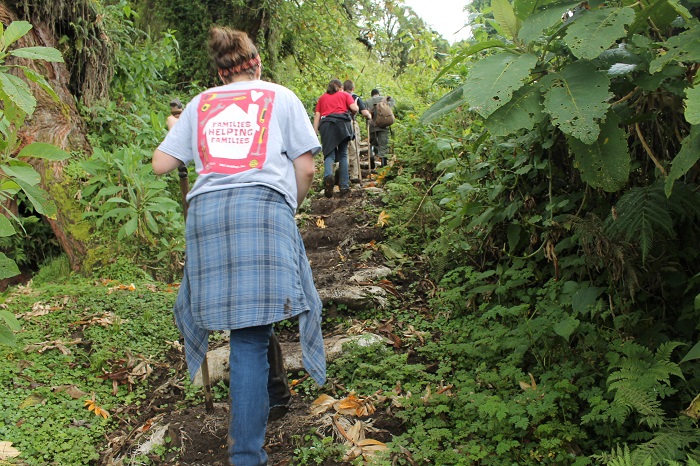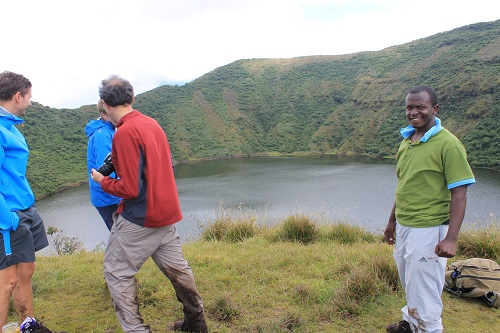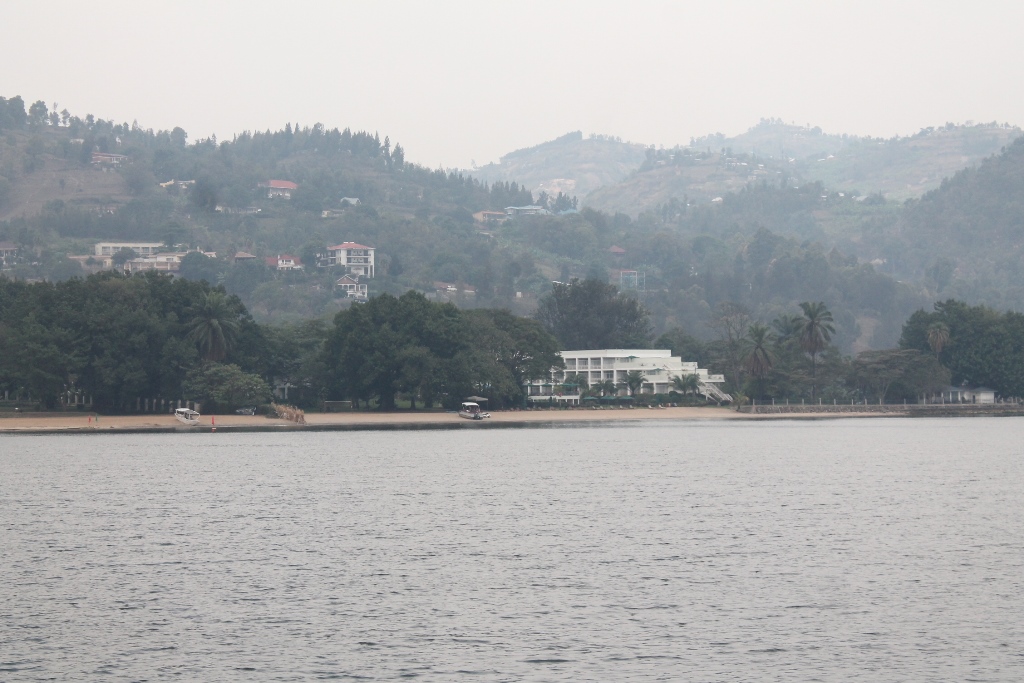
The Mount Bisoke (3711m) is the most popular destination for mountain trekking adventures in Rwanda. The mountain is part of the 5 volcanoes that make up the Volcanoes National Park, Rwanda’s most popular park that is famous for the mountain gorillas and golden monkeys in Rwanda.

Bisoke volcano has a large beautiful crater lake at the summit which is the ultimate prize that everyone hiking the volcano looks forward to. The trek on Mt. Bisoke also offers a good chance of seeing the gorillas as there are many gorilla families on this mountain. The beautiful golden monkeys are seen regularly on the mountain at the start of the trek or on the final descend, in the lower elevation of the mountains where they live.
The Mount Bisoke trek is a day tour that requires travelers to go up the mountain and return in one day, a grueling hike it can be even for the experienced hikers. The challenge is to hike to the summit of the volcano in not more than 6 hours as you will be on the watch out for the abrupt change in the weather at the summit which can quickly get covered in clouds that can release a hailstorm. The weather at the summit tends to change as the day passes and chances of rains are high in the afternoon. You are therefore constantly on your feet barely affording a minute to rest till you reach the summit before the weather changes. The earlier you make it to the summit, the more time you have to enjoy picnicking at the beautiful crater lake while the weather is still good. Many who do not anticipate the challenge give up within the first 30 minutes of the trek and return to base.
However, with adequate preparation and planning you can enjoy the trek on Mount Bisoke and make it to the summit
How to prepare for the Mount Bisoke trek?
Fitness
Fitness is crucial for the trek on Mount Bisoke. As you go higher up the mountain, oxygen levels drop which in turn affects the energy levels of your muscles. The fitter you are the more endurance you will have with less oxygen.
Therefore, do a lot of workouts and jogging a few weeks to your trek, especially for the non-experienced hikers. Find the highest elevations in neighborhood and practices walking or joining up in the shortest time to build endurance and power in your legs.
Acclimatization – sleep in Ruhengeri near the park
Fitness aside, the biggest effect on your trek is the change in altitude or elevation (you can call it altitude sickness). The higher you go, the less the oxygen in the atmosphere. If you are coming from a low altitude or elevation place, your body is used to using a lot of oxygen. So, with less oxygen as you go higher, your body will tire faster (compared to someone from a high altitude place).
To acclimatize your body to lower oxygen levels, you should opt to spend a day or few days in Ruhengeri district near the mountains before your trek. The area is located at a high altitude, more than 2000 meters above sea level. Your body may not adjust quickly but it will help somehow, in addition to good fitness.
Best time to trek Mount Bisoke – hiking during dry season vs rainy season
The season during which you hike Mountain Bisoke will also determine the level of difficult of your trek. Rwanda experiences two seasons, dry season and rainy season. The long dry season is from June to mid-September, and a short dry spell from December to February. Then there is the long rainy season is from March to May, and a short season from October to November.
The easier trek is definitely during the dry season when the trail is free from mud. However, note that even during the dry season the mountains experience sporadic rains and you should therefore be prepared, but it is never as bad as the rainy season.
Essential items to carry for the Bisoke trek
The following are essential for the trek
- Hiking shoes with good traction are essential for the trek. If you will hike during the wet/rainy season, there is no compromise on this.
- Long outdoor pants to protect the legs from scratches and bites from insects
- Long sleeved pants to protect hands from scratches
- A rain coat/jacket/poncho
- Garden gloves
- Hat/cap
- Sunscreen
To take a porter or not to take one
Porters are available for hire at only $10 to carry your backpack and any other item. Many trekkers think they will manage their small backpacks and don’t want to part with the $10. But after thirty minutes hiking up the mountain, even the watch on your wrist will feel like 1kg tied on your hand. It is therefore advised to hire a porter even when you feel able. In addition to carrying your backpack, the porter will provide a push or pull when the going gets tough.
Another reason to hire a porter is that you are directly contributing to the community near the gorillas. Porters are from the neighboring and some are former poachers and this is one way of keeping them away from poaching again.
Do not forget to take snacks for the trek
This is a common mistake for travelers, not taking a snack (and water) for the trek. The trek can drain you that by the time you get to the summit your belly is empty. At the summit you will sit to down to enjoy snack and “recharge” before the descend.
Book a Mount Bisoke tour
Leave a comment Cancel reply
Archives
- June 2025 (1)
- March 2025 (1)
- February 2025 (1)
- January 2025 (1)
- November 2024 (2)
- October 2024 (3)
- May 2024 (1)
- February 2024 (1)
- January 2024 (2)
- November 2023 (2)
- September 2023 (1)
- July 2023 (8)
- June 2023 (14)
- May 2023 (1)
- April 2023 (1)
- March 2023 (3)
- February 2023 (6)
- January 2023 (6)
- December 2022 (1)
- November 2022 (1)
- October 2022 (2)
- September 2022 (1)
- August 2022 (1)
- May 2022 (17)
- April 2022 (5)
- March 2022 (7)
- February 2022 (3)
- January 2022 (7)
- December 2021 (7)
- November 2021 (2)
- October 2021 (1)
- September 2021 (2)
- August 2021 (2)
- July 2021 (6)
- June 2021 (1)
- May 2021 (4)
- April 2021 (3)
- March 2021 (2)
- February 2021 (2)
- January 2021 (14)
- November 2020 (2)
- September 2020 (1)
- March 2020 (1)
- February 2020 (1)
- August 2019 (1)
- September 2016 (1)
- June 2016 (1)
- May 2016 (1)

